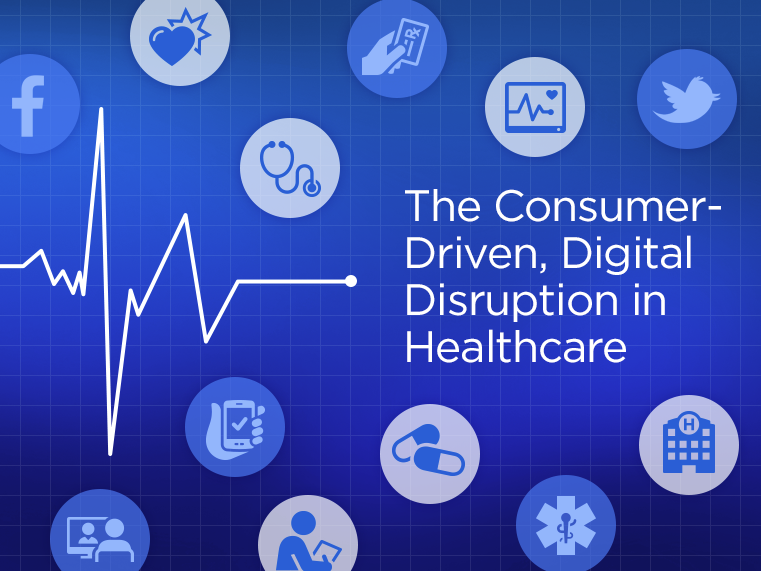
Many believe that medical companies, technological innovations, and government regulations are driving the digital disruption in healthcare — in reality, the industry is simply scrambling to keep up with consumer demand.

Many believe that medical companies, technological innovations, and government regulations are driving the digital disruption in healthcare — in reality, the industry is simply scrambling to keep up with consumer demand.
Historically speaking, the consumer/brand relationship has been pretty one-sided — companies have essentially held all of the cards, defining the evolution of the customer experience, product innovation, and consumption trends in general.
For example, every year the fashion industry dictates the hottest new styles and brands, TV networks and movie studios decide what we want to watch, tech companies set the bar for digital innovation, and we, the consumers, line up to buy whatever it is they’re selling. But the winds of change may be upon us — and they’ve started blowing in a somewhat surprising direction.
The Populist Power Grab

The healthcare industry is currently being rocked by digital disruption, but it’s not being led by industry giants, by technological innovation, or by government regulations and initiatives — rather, the change is being driven by the consumers themselves.
We’ve certainly seen these types of digital transformations before: Uber swooped in and turned the transportation industry completely on its head; AirBnB did the same thing to the vacation rental and hospitality space. But there’s an important distinction here: both of these examples involve companies inventing a new product or service model, which in turn invented the demand. It’s actually just the fashion and entertainment industry examples all over again. The change comes from what happens next.
If the success of these platforms demonstrates anything at all, it’s the fact that consumers value intuitive technologies and the convenience of on-demand services — just look at Uber, which is well on its way to a $62.5 billion valuation. And as the general population has grown increasingly accustomed to these new platforms and purchasing experiences, these expectations have proliferated across industry lines.
This is where the “consumer-driven” part of the conversation comes into the mix: the overwhelming success of companies in completely unrelated markets has caused a fundamental shift in the consumer/brand power dynamic — a shift that is transforming healthcare as we’ve come to know it. Consumers are now calling the shots, and the industry is scrambling to keep up.
Healthcare is Getting a Digital Facelift

Now that digital optimization and on-demand experiences have become a baseline expectation for consumers across the board, the healthcare industry has been forced to cede some of its power and adapt its approach to the patient experience.
We’ve already seen this happening with the “Uber-ization” of medical appointments. As the Wall Street Jounal reports, a host of companies like Heal, Dispatch, Pager, and MedZed have made waves with app-enabled house calls (or office calls, as the case may be). Back in 1930, nearly 40% of doctor visits were at-home, but by the early 1980s, the trend had all but vanished. Today, the massive proliferation of one-touch, on-demand smartphone services are forcing doctors to bring back the personalized approach — or risk losing patients to others who are more flexible and willing to embrace this trend.
Of course, the trend is much, much larger than home visits. As Forbes notes, there’s been a paradigm shift in the public conception of how healthcare works: instead of reactively treating sickness, consumers are proactively seeking health. Here’s a quick overview of just a few corners of the health market in which consumer-driven demand has already made an impact:
- Forms of remote care, such as telemedicine, are booming. Today, 84% of those 18-34 would prefer a mobile-mediated consultation to an office visit, and there will be three million remotely-monitored patients by 2019.
- Consumers are purchasing high-tech wearables and connected devices by the millions to improve their overall health and well-being. Wearable market revenues reached $12.6 billion last year, and will hit $95.3 billion by 2021.
- Demand for increased efficiency and price transparency has prompted a surge of venture capital investment into disruptive digital health and biotech startups. Funding topped $16 billion last year, up 34% from 2014.
- 95% of consumers demand online access to health records, says Accenture, driving cloud adoption and making software a “core competency” for medical companies. Widespread interconnection of medical devices could save healthcare $30 billion annually.
And no matter your opinion of policy, recent legislation also indicates a trend towards market reactionism. For example, portions of the Affordable Care Act, such as price transparency requirements and the institution of an online, open-access marketplace, are responses to consumer demand for personal control. See also the federal government’s $30 billion dollar push for electronic health records in 2009.
Consumer Data and Online Engagement Have Set the Bar

Early-adopters have already experienced a huge return on their willingness to play ball. For example, Google’s opportunistic approach to healthcare has turned into a mutli-billion dollar venture — the company has utilized powerful data analytics, machine learning, and pattern recognition technologies to transform diagnostic and treatment techniques.
Many medical marketers are using some of these same technologies to identify and engage with prospective patients. Traditional mass-participation surveys like the NHIS are becoming more difficult to conduct, which means that online behavioral analysis and demographic targeting have become gold standards for discovering what it is that patients want and how to connect with them more effectively.
Despite their longtime reliance on traditional media channels such as radio, print, and television, it’s become clear that medical marketers must recognize the latest trends and consumer expectations and react accordingly, or risk alienating their target audiences and losing out to their more forward-thinking competitors. At the end of the day, healthcare is all about helping people — whether it’s a patient describing their symptoms, or their struggle to book an appointment online, it’s the job of medical professionals to do everything within their power to serve the patient’s needs.
Healthcare has been in need of a major disruption for some time and it now has the technological and digital means necessary to facilitate one. And at long last, we, the consumers, are the ones in the driver’s seat, controlling the narrative and forcing the industry to meet our evolving demands.
(Image credits: WenPhotos/Pixabay, fancycrave1/Pixabay, geralt/Pixabay)
![]()








